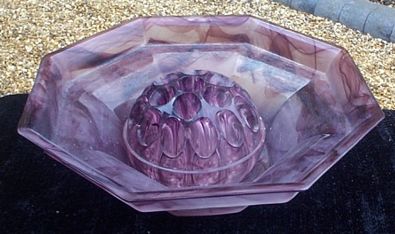|
|
||||||||||||||||||||||
|
||||||||||||||||||||||

Cloud glass was made by adding trails of a darker coloured glass to a gather of light colour glass in the mould. When the plunger of the mould was lowered the darker trails would be randomly spread throughout the lighter glass. The random nature of this process ensured that the colouring of each piece was unique. This simple process turned pressed glass into much more of an 'art glass' and ensured its success with the buying public.
 Cloud Glass looks at it's best
when viewed with the light behind it. This also makes it very difficult
to photograph well!!! The random nature of the trails also has a marked affect
on the desirability of a piece. If a piece has too many trails, then it
will appear dark and uninteresting, too few trails, and the piece will have a
washed out appearance. In some pieces, notably amber cloud, the trails are
thick like ribbons (see right). Consequently collectors call this 'Ribbon Cloud'.
Although Ribbon Cloud is not aesthetically pleasing, it is sought
after by some collectors for its rarity.
Cloud Glass looks at it's best
when viewed with the light behind it. This also makes it very difficult
to photograph well!!! The random nature of the trails also has a marked affect
on the desirability of a piece. If a piece has too many trails, then it
will appear dark and uninteresting, too few trails, and the piece will have a
washed out appearance. In some pieces, notably amber cloud, the trails are
thick like ribbons (see right). Consequently collectors call this 'Ribbon Cloud'.
Although Ribbon Cloud is not aesthetically pleasing, it is sought
after by some collectors for its rarity.
Normally one surface of the completed piece was treated to give it a matt appearance. The majority of examples found today are like this. It is rare to find Cloud Glass which is polished or matt on all surfaces. Such pieces are sought after for their rarity. Amber Cloud which is polished on all surfaces is called Tortoiseshell by collectors. Pieces which are matt on both sides can be particularly pleasing to the eye.
The process of making cloud glass was never patented as some sources have suggested. Perhaps this was because mixing two colours of glass together was not a new process and therefore could not be patented. However, Davidson did manage to patent the idea of painting glass, as they successfully registered a patent for Ora or Red Cloud Glass.
Cloud Glass comes in many different colours, and are sometimes known by different names by different collectors. The following is a list of all the known colours. The only colours which were produced by Davidson were Purple/Amethyst, Blue, Amber, Green, Orange, Red and Topaz-Briar. Walther produced Amber, Sepia, Violet, Topaz-Violet, Pink and Butterscotch. There is plenty of debate about who produced the other colours. There are known pieces of Cloud glass produced by Jobling and Sowerby.
| Colour | Manufacturer | Date made |
| Purple/Amethyst | Davidson | 1923 to 1934 |
| Purple/Amethyst | Sowerby | Mid to late 1960s |
| Blue | Davidson | 1925 to 1934 |
| Amber | Davidson | 1928 to 1957 |
| Amber | Walther | 1932 ? to 1939 ? |
| Amber | Brockwitz | 1934 ? to 1939 ? |
| Amber | Sowerby | Unknown |
| Tortoiseshell | Davidson | 1928 to 1957 |
| Tortoiseshell | Jobling | 1936 to 1937 |
| Green | Davidson | 1934 to 1941 |
| Red (Ora) | Davidson | 1929 to 1932 |
| Orange | Davidson | 1933 to 1935 |
| Topaz-Briar | Davidson | 1957 to 1961 |
| Sepia | Walther | 1932 to 1939 |
| Violet | Walther | 1932 to 1939 |
| Topaz-Violet | Walther | 1935 to 1939 |
| Pink | Walther | 1935 to 1939 |
| Butterscotch | Walther | 1935 to 1939 |
| Grey | S Reich & Co. | Unknown |
| Lavender | Walther | 1935 to 1939 |
| Cobalt Blue | S Reich & Co. | Unknown |
| Inky-Violet | S Reich & Co. | Unknown |
| Lime-Green | S Reich & Co. | Unknown |
|
|
|
|